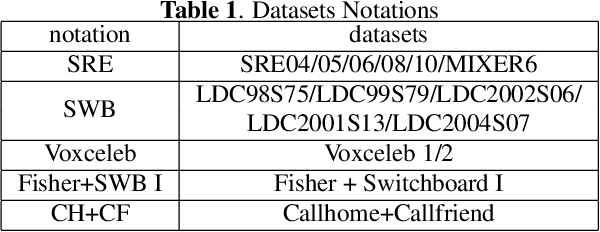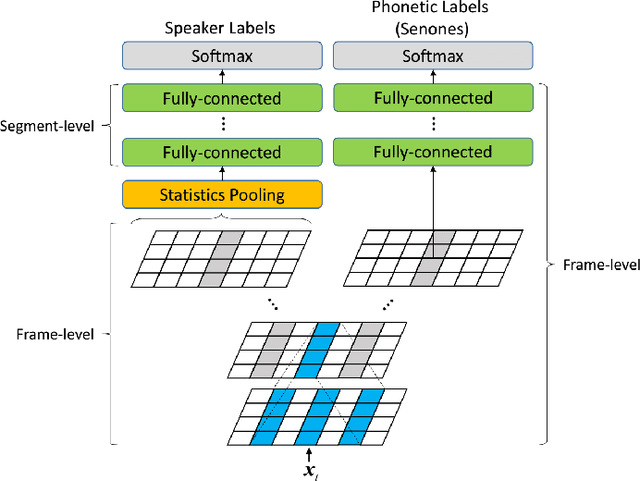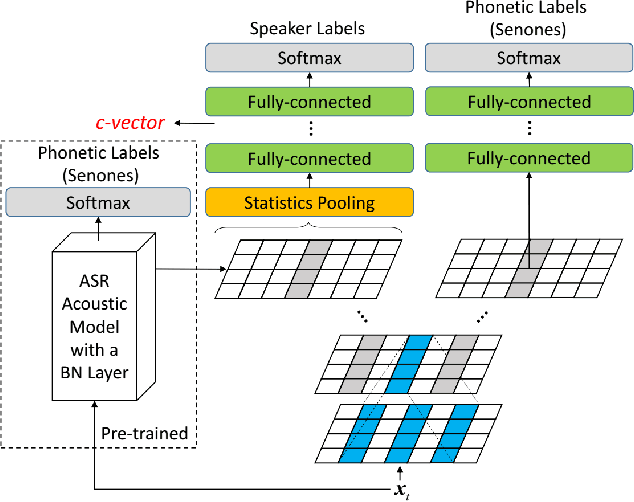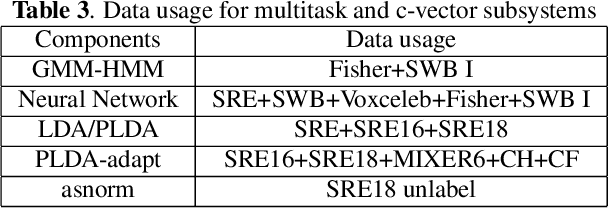Tianlong Kong
THUEE system description for NIST 2020 SRE CTS challenge
Oct 12, 2022



Abstract:This paper presents the system description of the THUEE team for the NIST 2020 Speaker Recognition Evaluation (SRE) conversational telephone speech (CTS) challenge. The subsystems including ResNet74, ResNet152, and RepVGG-B2 are developed as speaker embedding extractors in this evaluation. We used combined AM-Softmax and AAM-Softmax based loss functions, namely CM-Softmax. We adopted a two-staged training strategy to further improve system performance. We fused all individual systems as our final submission. Our approach leads to excellent performance and ranks 1st in the challenge.
SpeechNAS: Towards Better Trade-off between Latency and Accuracy for Large-Scale Speaker Verification
Sep 18, 2021



Abstract:Recently, x-vector has been a successful and popular approach for speaker verification, which employs a time delay neural network (TDNN) and statistics pooling to extract speaker characterizing embedding from variable-length utterances. Improvement upon the x-vector has been an active research area, and enormous neural networks have been elaborately designed based on the x-vector, eg, extended TDNN (E-TDNN), factorized TDNN (F-TDNN), and densely connected TDNN (D-TDNN). In this work, we try to identify the optimal architectures from a TDNN based search space employing neural architecture search (NAS), named SpeechNAS. Leveraging the recent advances in the speaker recognition, such as high-order statistics pooling, multi-branch mechanism, D-TDNN and angular additive margin softmax (AAM) loss with a minimum hyper-spherical energy (MHE), SpeechNAS automatically discovers five network architectures, from SpeechNAS-1 to SpeechNAS-5, of various numbers of parameters and GFLOPs on the large-scale text-independent speaker recognition dataset VoxCeleb1. Our derived best neural network achieves an equal error rate (EER) of 1.02% on the standard test set of VoxCeleb1, which surpasses previous TDNN based state-of-the-art approaches by a large margin. Code and trained weights are in https://github.com/wentaozhu/speechnas.git
Dynamic Multi-scale Convolution for Dialect Identification
Aug 02, 2021



Abstract:Time Delay Neural Networks (TDNN)-based methods are widely used in dialect identification. However, in previous work with TDNN application, subtle variant is being neglected in different feature scales. To address this issue, we propose a new architecture, named dynamic multi-scale convolution, which consists of dynamic kernel convolution, local multi-scale learning, and global multi-scale pooling. Dynamic kernel convolution captures features between short-term and long-term context adaptively. Local multi-scale learning, which represents multi-scale features at a granular level, is able to increase the range of receptive fields for convolution operation. Besides, global multi-scale pooling is applied to aggregate features from different bottleneck layers in order to collect information from multiple aspects. The proposed architecture significantly outperforms state-of-the-art system on the AP20-OLR-dialect-task of oriental language recognition (OLR) challenge 2020, with the best average cost performance (Cavg) of 0.067 and the best equal error rate (EER) of 6.52%. Compared with the known best results, our method achieves 9% of Cavg and 45% of EER relative improvement, respectively. Furthermore, the parameters of proposed model are 91% fewer than the best known model.
 Add to Chrome
Add to Chrome Add to Firefox
Add to Firefox Add to Edge
Add to Edge